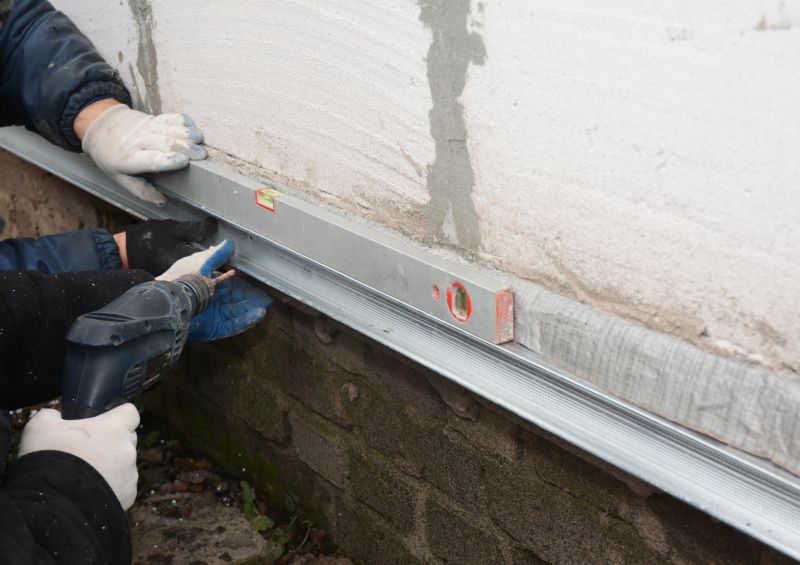Popular Foundation Repair Options for Improving Structural Integrity
Choose from proven products designed to reinforce and restore your home's foundation safely and effectively.
 Foundation repairs are a critical aspect of maintaining the structural integrity of a building. When signs of foundation issues such as cracks, uneven floors, or doors that don’t close properly appear, it is essential to consider a range of repair products designed to stabilize and reinforce the foundation. These products vary widely in their application, from simple patching materials to complex underpinning systems. Understanding the different options available can help homeowners and contractors select the most appropriate solutions for specific situations.
Foundation repairs are a critical aspect of maintaining the structural integrity of a building. When signs of foundation issues such as cracks, uneven floors, or doors that don’t close properly appear, it is essential to consider a range of repair products designed to stabilize and reinforce the foundation. These products vary widely in their application, from simple patching materials to complex underpinning systems. Understanding the different options available can help homeowners and contractors select the most appropriate solutions for specific situations.
Types of Products For Foundation Repairs
Hydraulic Piers
Adjustable hydraulic piers are used to lift and stabilize sinking foundations by transferring weight to deeper, more stable soil layers.
Underpinning Systems
Underpinning involves reinforcing existing foundations with various support systems to prevent further settling or shifting.
Crack Injection Kits
These kits are designed to seal cracks in concrete and masonry, preventing water intrusion and further damage.
Soil Stabilization Products
Materials that improve soil strength and reduce movement, often used beneath the foundation to prevent shifting.
Carbon Fiber Reinforcement
Fiber strips or fabrics used to reinforce cracked walls and prevent further cracking in concrete structures.
Mudjacking and Slab Jacking
A process of injecting material beneath concrete slabs to lift and level uneven surfaces caused by soil settlement.
Drainage Systems
Proper drainage solutions help prevent water accumulation around the foundation, reducing soil erosion and pressure.
Waterproofing Membranes
Applied to foundation walls to prevent water infiltration and moisture-related issues.
Anchor Bolts and Braces
Used to stabilize walls and prevent movement or collapse due to shifting soil or other forces.
Polyurethane Foam Fillers
Expanding foam used to fill small cracks and voids, providing quick stabilization and sealing.
Foundation Repair Plates
Metal plates that reinforce cracked or bowed walls, distributing stress and preventing further damage.
Grout and Epoxy Resins
Used to fill and seal cracks, providing structural support and preventing water ingress.
Helical Piles
Deep foundation support systems that are screwed into the ground to provide stability for heavy loads.
Concrete Patching Materials
Materials designed for repairing surface cracks and spalling in concrete foundations.
Vapor Barriers
Installed beneath slabs or on walls to prevent moisture migration and protect foundation materials.
Popular Choices
Widely used for foundation stabilization, hydraulic piers are favored for their adjustability and strength.
Commonly selected for sealing cracks in concrete, these kits are accessible for DIY repairs.
Frequently chosen for leveling slabs, mudjacking offers a non-invasive repair method.
Popular for addressing ground movement, these products help improve foundation support.
Essential for moisture control, waterproofing membranes are a common choice for foundation protection.
Increasingly used to reinforce cracked walls, carbon fiber materials are gaining popularity.
Effective drainage solutions are frequently installed to reduce water-related foundation issues.
Popular for quick crack sealing and void filling, polyurethane foam is easy to apply.
Commonly used to stabilize walls and prevent collapse, these hardware solutions are widely implemented.
Frequently selected for surface repairs, these materials help restore concrete integrity.
Growing in popularity for deep support, helical piles are used in challenging soil conditions.
Commonly installed to control moisture, vapor barriers are a staple in foundation protection.
Many foundation repair products are engineered to address common problems like settling, shifting, or cracking. For instance, hydraulic piers and underpinning systems can provide long-term stabilization by transferring the load to more stable soil layers. Crack injection kits are often used to seal small to medium-sized cracks, preventing water infiltration and further deterioration. Additionally, soil stabilization products help improve the ground beneath the foundation, reducing movement caused by moisture changes or soil erosion.
Proper selection and application of foundation repair products require careful assessment of the underlying issues. Factors such as soil type, extent of damage, and the building's load capacity influence the choice of repair methods. While some products are suitable for DIY projects, others necessitate professional installation to ensure safety and effectiveness. Regular inspection and maintenance can prolong the lifespan of foundation repairs, helping to preserve the stability of the structure over time.
Key Buying Considerations
- Assess the extent and type of foundation damage to determine suitable repair products.
- Consider the soil type and moisture conditions around the property, as these influence repair effectiveness.
- Evaluate whether a DIY approach is feasible or if professional installation is recommended.
- Check product compatibility with existing foundation materials such as concrete or masonry.
- Determine the load-bearing requirements to select appropriately rated stabilization systems.
- Review the installation process and time requirements for each product type.
- Consider long-term maintenance needs and the durability of the repair solutions.
- Ensure that products meet relevant safety standards and certifications.
- Factor in the potential for future repairs when choosing versatile or adjustable systems.
- Compare costs and warranties offered by different products and suppliers.
- Look for products that offer clear instructions and technical support if needed.
- Prioritize solutions that address both structural support and moisture control when applicable.
- Understand the limitations of each product to avoid over-reliance on a single repair method.
- Consult with a foundation specialist or structural engineer for complex issues.
- Review customer feedback and product reviews to gauge real-world performance.
